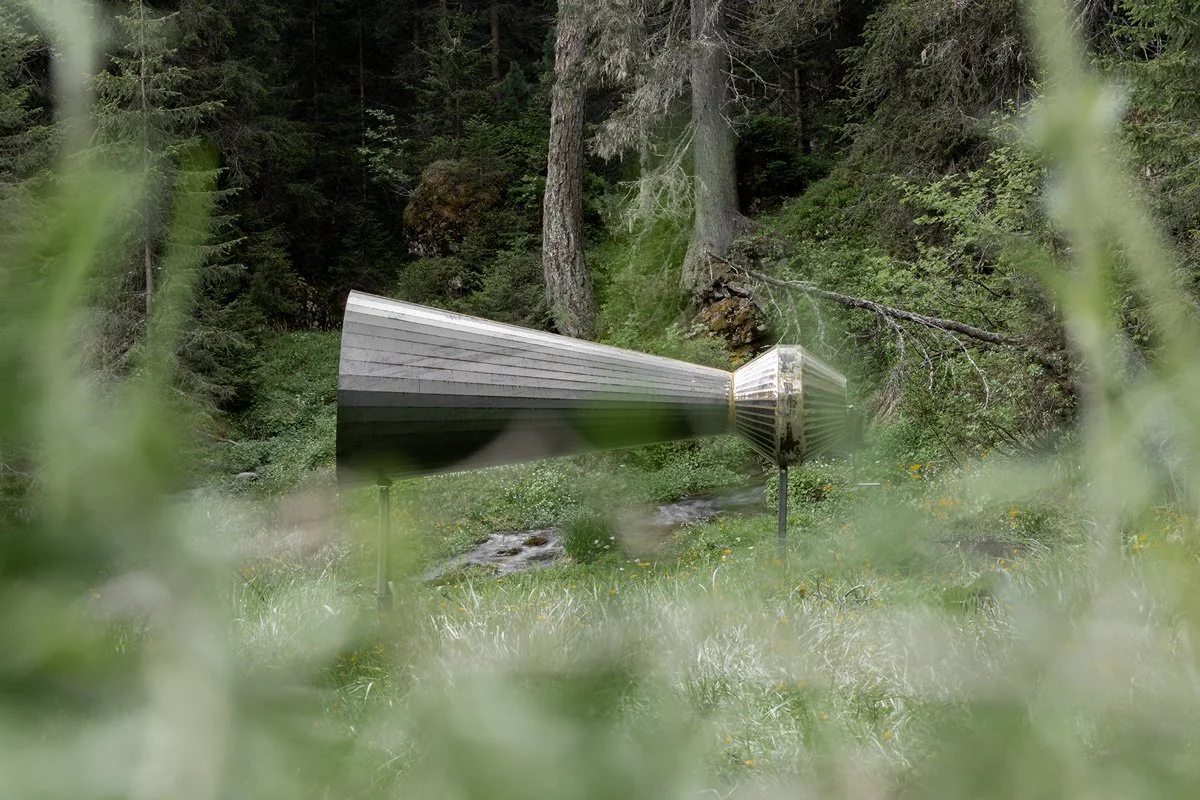Sway
Lola Giuffré (Studio Lola)
“Sway” means to oscillate or swing. The installation, in fact, is activated by the wind, which, depending on its force, makes it gently sway or fully rotate. Giuffré, who trained as an engineer but specialized in jewelry making, explains that her inspiration came from visualizing the trajectory of a scythe cutting grass. Manual scything has been used for centuries in these meadows, and its technique requires constant and repetitive movements. In her jewelry work, as well as in the creation of the concave aluminum elements of this piece, Giuffré employs processes like hammering that demand time, patience, and repetitive motions. Craftsmanship, moreover, reflects long working hours, in harmony with nature and the raw materials it provides. The combination of the technical and natural worlds is also made explicit by the choice to use tree branches in dialogue and collaboration with the other metallic elements of the installation.






Exhibit place Armentara
The Armentara meadows – whose name derives from the Ladin word armënt, in Italian armenti, meaning herd of large domesticated animals, in the extended sense armentara is therefore the place of grazing – are situated between 1,600 and 2,000 m above sea level below the rock faces of the Sasso di Santa Croce and are part of the Fanes-Senes-Braies Nature Park. From the viewpoint of flora and fauna, these meadows are of extraordinary importance. In contrast to ‘fat meadows’, which are fertilised meadows where the grass grows taller but with less variety in the flora, these are ‘lean meadows’. The soil is quite acidic and low in nutrients, which means that the grass grows low but with a great variety of flowers and herbs: arnica, orchids, bluebells, snowdrops, carnations, mountain geraniums, golden buttons, anemones, gentians, pulsatillas, sorrel, clover, crocus, silene gonfiata and many others. But Armentara is also famous for its great biodiversity: 244 types of mushrooms, 65 mosses, 55 spiders, 43 birds, 40 butterflies and 10 ants grow and live here!
Back to flowers: if you happen to pass through here between May and June, you will find, for example, the meadows all pink from the blossoming of the alpine carnations, many of them of the ‘Fior di cuculo’ or lychnis flos-cuculi variety. There are some English legends about these flowers (which will be spoken of in the Fanes paragraph within the thousands of Ladin legends). One says that when one picks a flower, one hears the sound of thunder, and another says that lovers once placed the buds of these flowers under their corsets, naming each one after a boy. The flower that would bloom first, with the warmth of her body, would reveal who her future husband would be.
But Armentara is not only rich in carnations, but also in other ‘magic’ flowers that change according to the season. The ‘Pulsatiles de munt’ (Alpine anemone), for example, blossoms in spring and is yellow or white. However, after flowering, it produces an infructescence that looks like a tuft of hair. Because of their somewhat shaggy appearance, they have been given various popular nicknames. In Ladin they call them stries, ‘witches’, because they are as dishevelled as one imagines them to be. Then there are the ‘Milandures’ (crocus vernus), which herald spring with their blossoming and colour whole meadows white or pink-purple, while in autumn the flower has no leaves and if eaten – unfortunately it happens from time to time since this type of crocus belongs to the same family and resembles the crocus sativus that gives saffron – it can be deadly.
Finally, a useful tip, the flowers also indicate the type of soil they ‘hide’ underneath. Beware, for example, of the pretty downy tufts of ‘Baudli de parü’ (Eriophorum) growing in marshy soil!












